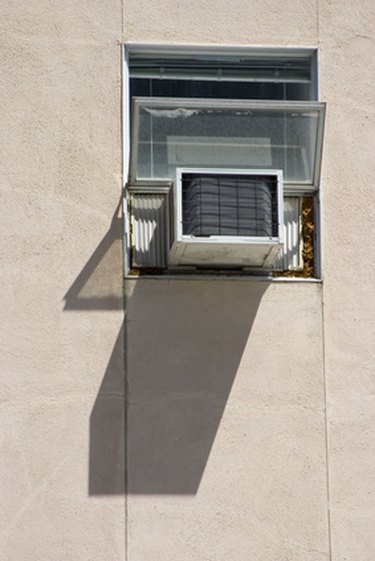Things You'll Need
Adjustable wrench
Low-loss refrigerant hose
Refrigerant recovery tank
Refrigerant manifold gauges

All CFC and HCFC refrigerants destroy ozone. Because of this the Environmental Protection Agency (EPA) has required the eventual elimination of these types of refrigerants. By the year 2020 all HCFC and CFC refrigerants available for use will come from old systems that have had the refrigerant recovered, reclaimed or recycled. When an air conditioning technician uses his refrigerant recovery machine he not only helps the environment, he also extends the likelihood that future technicians will have the refrigerant needed to service air conditioning systems installed within the last few years.
Step 1
Unscrew the brass service port covers from the air conditioner's high-pressure and low-pressure service valves. Use an adjustable wrench to loosen the caps. The service valves, located where the refrigerant lines enter the condenser, allow access to the refrigerant inside of the system.
Video of the Day
Step 2
Push a low-loss refrigerant hose onto the recovery unit's "Discharge" port. All ports on the recovery unit will have labels identifying them. The low-loss refrigerant hose has locking slide-on fittings, on both ends, that push over a locking hub found on the recovery unit and recovery tank. The fittings snap into place when fully connected.
Step 3
Push the other end of the low-loss refrigerant hose onto the "Liquid" port of a refrigerant recovery tank. The tank will have two ports, labeled "Liquid" and "Vapor."
Step 4
Connect the middle hose from a refrigerant manifold gauge set to the air conditioner's low-pressure service port. The low-pressure service port, also called the suction port, connects to the large refrigerant line.
Step 5
Screw the manifold's left hose, the low-pressure hose, to the recovery unit's "Suction" port.
Step 6
Screw the manifold's right hose, the high-pressure hose, to the recovery tank's "Vapor" port.
Step 7
Turn the manifold valve's handles to the "closed" position. Handles located on each side of the manifold, above the left and right hose connections, open and close valves inside of the manifolds.
Step 8
Plug the recovery unit into a wall outlet. If needed, use the smallest extension cord possible.
Step 9
Turn the recovery tank's valves, located on top of the tank, to the "open" position.
Step 10
Turn the recovery unit's power switch to the "on" position.
Step 11
Run the recovery unit until the low-pressure gauge on the manifold set reads the proper vacuum. Use the recovery-unit manufacturer's refrigerant table, found on a sticker located on the side of the recovery unit, to find the proper amount of vacuum for the type of refrigerant in the air conditioning system. The air conditioner's identification label lists the type of refrigerant used.
Step 12
Close the manifold's valves.
Step 13
Close the recovery tank's valves.
Step 14
Turn the recovery unit's power switch to the "off" position.
Step 15
Disconnect all hoses.
Warning
Always watch the manifold's high-pressure gauge. If the gauge reaches the tank's burst level, as stated on the top of the tank next to the valves, then turn the recovery unit off.
Video of the Day